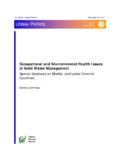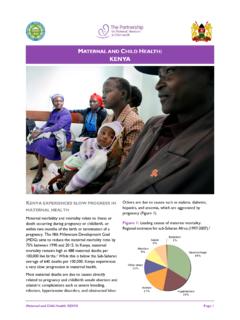Transcription of MATERNAL AND CHILD H UGANDA Embolism - WHO
1 MATERNAL and CHILD Health: UGANDA Page 1 UGANDA EXPERIENCES SLOW PROGRESS IN MATERNAL HEALTH MATERNAL morbidity and mortality relate to illness or death occurring during pregnancy or childbirth, or within two months of the birth or termination of a pregnancy. The fifth Millennium Development Goal (MDG) aims to reduce the MATERNAL mortality ratio by 75% between 1990 and 2015. In UGANDA , MATERNAL mortality remains high at 440 MATERNAL deaths per 100,000 live births1. For every MATERNAL death in UGANDA , at least six survive with chronic and debilitating ill health2. Most MATERNAL deaths are due to causes directly related to pregnancy and childbirth unsafe abortion and obstetric complications such as severe bleeding, infection, hypertensive disorders, and obstructed labor3. Others are due to causes such as malaria, diabetes, hepatitis, and anaemia, which are aggravated by pregnancy (Figure 1).
2 Figure 1: Leading causes of MATERNAL mortality: Regional estimates for sub-Saharan Africa (1997-2007)3. Haemorrhage34%Hypertension19%Indirect17% Other direct11%Abortion9%Sepsis9%Embolism1% MATERNAL AND CHILD HEALTH: UGANDA MATERNAL and CHILD Health: UGANDA Page 2 Data on MATERNAL morbidity in UGANDA is limited as 62% of women are delivering outside health facilities, without skilled care2. Health systems challenges and poor social determinants of health slow the improvement of women s and children s health. Difficult access to quality services, a shortage of trained and motivated health care professionals and shortages of essential drugs and medicines contribute to high mortality and morbidity rates. Coverage of interventions is also inequitable in UGANDA . While approximately 94% of women giving birth received some antenatal care by a healthcare professional (doctors, nurses and midwives), in rural areas, only 36% of women delivered in a health facility compared to 79% in urban areas.
3 Similarly, women in the highest wealth quintile were 3 times more likely to deliver in a health facility than women in the lowest wealth quintile4. Together with income, education also plays a major role in determining MATERNAL health outcomes, including fertility rates, access to family planning, and antenatal coverage. Women in UGANDA with higher education are much more likely to deliver in a health facility than women with no education (75% vs. 25%). Restrictive abortion legislation also contributes substantially to MATERNAL mortality and morbidity in Uganda5. UGANDA RANKED 19TH GLOBALLY IN UNDER-5 DEATHS Over 7 million children globally under-5 years of age die each year mainly from preventable and treatable conditions. Pneumonia, diarrhoea and malaria remain the leading cause of CHILD mortality, and under nutrition contributes to more than one-third of all deaths.
4 Millions of children could be saved each year if proven interventions such as antibiotics for pneumonia, oral rehydration therapy for diarrhoea, and the provision of insecticide treated nets (ITNs) to prevent malaria, were universally available. While infant and under-5 mortality rates have declined from 186 deaths per 1000 in 1990 to 135 in 2008, UGANDA is not on track to meet MDG 4 to reduce the under-5 mortality by two thirds between 1990 and 20156 and is ranked 19th country globally with the highest under-5 deaths7. Nearly 21% of under-5 deaths occurred during the neonatal period (Figure 2); 30% of all neonatal deaths are due to preterm births and asphyxia, followed by severe infections. Just over 75% of under-5 deaths are post-neonatal7 and leading causes of these deaths are malaria, diarrhoea, and pneumonia (Figure 2). In 2009, UGANDA also experienced over 38,000 stillbirths8.
5 The probability of dying between the first and fifth birthday for rural infants is 45% higher than for urban infants4. There are persistently high rates of malnutrition in UGANDA : 38% of children under 5 suffer from chronic malnutrition (stunting), 16% from underweight and 6% from acute malnutrition3, 9. Figure 2: Under-5 mortality by cause of death in UGANDA (2008)3. Other13%Injuries4%HIV/AIDS4%Diarrhoeal diseases (post neonatal)14%Neonatal21%Diarrhoea14%Malar ia19%Pneumonia11% Figure 3: Under-5 mortality in UGANDA by background characteristics (1996-2006)4. 1141531691021721080204060801001201401601 80 UrbanMotherwith noeducationLowestwealthquintile Socioeconomic status is a key determinant of survival. Under-5 children in the lowest wealth quintile in UGANDA are nearly times more likely to die than those in the highest quintile8, 10. The biggest differential in the under-5 mortality ratio in UGANDA is related to mother's education (Figure 3).
6 Water supply, sanitation and hygiene (WASH)-related diseases and associated conditions ( , anemia, dehydration and malnutrition) are a leading cause of under-5 hospitalization and mortality. Poor sanitation coupled with unsafe water sources has contributed significantly to the disease burden in UGANDA , including dysentery, diarrhoea and typhoid fever where improved sanitation facilities and access to water supply remain poor. Only 48% of households have improved sanitation facilities while only 67% have access to improved drinking water sources4. Although UGANDA has launched broad reform, efforts around water and sanitation will need to be stepped up considerably in order to reach the MDG targets by 201511. MATERNAL and CHILD Health: UGANDA Page 3 GOVERNMENT COMMITMENT TO WOMEN AND CHILD HEALTH The Constitution of UGANDA sets out the State s duty to ensure all Ugandans enjoy access to health services and to take all practical measures to ensure the provision of basic medical services to the population.
7 However, there is no specific provision on the right to health12. The national Safe Motherhood Program (SMP) has guided the promotion of MATERNAL health in UGANDA . As part of this program, a number of initiatives were established in the last decade, including building a supportive community network of traditional birth attendants (TBAs) as a backup for a modern MATERNAL health system, and interventions to forecast high-risk obstetric events and strengthen referral systems. The national population policy seeks to reduce fertility and MATERNAL morbidity and mortality by promoting informed choice, service accessibility and improved quality of care13. In response to the lower status of women in many parts of the society, the government adopted a national gender policy in 1997 with the goal of integrating gender into community and national development. The policy intends to empower women in decision-making processes as a key to development13.
8 In recognition of the special reproductive health needs of adolescents, the government has drafted an adolescent health policy. The policy seeks to promote adolescent friendly services, sex education and building life skills. In addition, the policy sets the minimum age for marriage at 18 years to counter the high rates of adolescent pregnancy13. In 1996, the government adopted universal primary education as a strategy to improve population literacy. This policy has increased the school enrolment of both girls and boys. In the long term, it is hoped that the benefits of schooling will be reflected in MATERNAL and reproductive health indicators13. The burden of malaria in UGANDA is high with estimated 70-100,000 deaths per year among children under 5 years of age and between 10 and 12 million clinical cases treated in the public health system alone. The National Malaria Control Strategy has lead to progress towards effective malaria control through ITNs and internal residual spraying (IRS) in low lying and epidemic prone areas14.
9 In 2010, the Global Strategy for Women s and Children s Health was launched by the office of the United Nations Secretary-General. The Initiative calls for a bold, coordinated effort around MDGs 4 and 5, building on what has been achieved so far - locally, nationally, regionally and globally. It calls for all partners to unite and take action through enhanced financing, strengthened policy and improved service delivery. UGANDA has made the following commitments to the Global Strategy: Ensure that comprehensive Emergency Obstetric and Newborn Care (EmONC) services in hospitals increase from 70% to 100% and in health centers from 17% to 50%; Ensure that basic EmONC services are available in all health centers; ensure that skilled providers are available in hard to reach/hard to serve areas. UGANDA also commits to reduce the unmet need for family planning from 40% to 20%; Increase focused Antenatal Care from 42% to 75%, with special emphasis on Prevention of Mother-to- CHILD Transmission (PMTCT) and treatment of HIV; Ensure that at least 80% of under 5 children with diarrhea, pneumonia or malaria have access to treatment; to access to oral rehydration salts and Zinc within 24 hours, to improve immunization coverage to 85%, and to introduce pneumococcal and human papilloma virus (HPV) vaccines.
10 As of 2011, UGANDA is off track on these commitments15. UGANDA is one of ten countries globally which contribute the highest MATERNAL , Newborn and CHILD Mortality rate in the world. Particularly central to this problem is the current health worker gap, especially of midwives at community level health centers, to deliver the range of life saving interventions. UGANDA has a shortfall of 2,000 midwives, not because of lack of trained midwives but due to the current government restrictions on recruitment of health workers16. UGANDA also hosted the 2010 African Union Summit of Heads of State and Government on MATERNAL , Newborn and CHILD Health and Development in Africa17. PARLIAMENTARIANS PLAY AN IMPORTANT ROLE IN IMPROVING HEALTH Parliamentarians are fundamental to the development of issues and critical to improving the health of women and children. Parliamentarians engagement in MNCH issues not only benefits women and children, but also strengthens the role of parliamentarians in influencing national health and development.
















